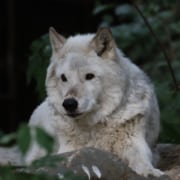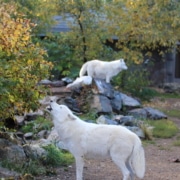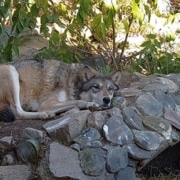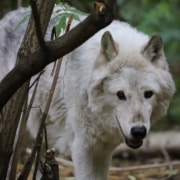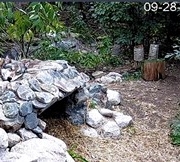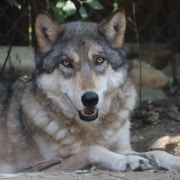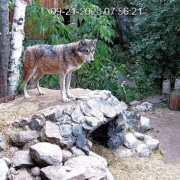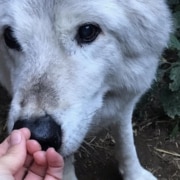Archives
Boltz had a vet check on Tuesday and while we think he has improved since he was removed from the Exhibit Pack on September 15th, there isn’t enough of an improvement to indicate that the prednisone treatment is working. Every decision we make has to be balanced between risk and benefit. Initially, we put him on prednisone while he was in the main enclosure in hopes to find some relief to this condition that would have allowed him to stay in the pack, at least until we could narrow down a diagnosis. When it became clear that the initial dose of prednisone wasn’t effective, we reassessed risks and benefits and made the move to the Pack Holding Area. Now, we are again reassessing and are in the slow process of transitioning him off of the prednisone treatment. Since we made that decision, we do notice that he is much less anxious and resting more comfortably. The surveillance cameras are tremendous in revealing how long he sleeps and how often he may change positions. This mornings review of the overnight footage revealed that he went to bed about midnight and didn’t get up until the wolf care staff arrived at 8 am. He was alert and stretching several times through the night, but no indication that he was uncomfortable in his resting position.
What are the next steps? Thanks to some advice from Walter, a long-time ambassador wolf supporter, we located a research paper from the University of Florida concerning research on Degenerative Myelopathy in German Shepard dogs. While we don’t know if Boltz has DM, we feel it is appropriate to act on some of the recommendations based on that research. According to their study:
“DM progresses at different rates and “stress” plays a role in its advancement. Minimizing stressful situations is important where possible.”
For Boltz, moving him into a quiet safe environment and minimizing activity in the wolf yard has definitely decreased stress. Other than a few moments of anxiety when someone pulls up to the back driveway, he is either calmly relaxing on the den, within the straw beds of the protective kennel or found sleeping in the thick straw inside the den.
Another statement from the paper shows some possible pharmaceutical treatments that may help:
” Over the last 2 decades, we have found 2 medications which appear to prevent progression or result in clinical remission of DM in many (up to 80%) of the patients. These medications are aminocaproic acid (EACA) and n-acetylcysteine (NAC).”
During or Vet check on Tuesday, we discussed these treatments with our Vet and have been in contact with a pharmacy that cooperated on the University of Florida study to determine dosages and delivery methods. Being able to get Boltz to take medication is important, powders and liquids are a challenge for a wolf that is neophobic (fearful or mistrusting of new stimuli) or more inclined to scent roll on things that smell different. Most of our med delivery is done in a pill form, often hidden inside a chicken leg with a tab of butter as binding agent.
The paper also suggests some nutritional supplements that may help his overall immune system. We have ordered the following and will be starting them as soon as they arrive. We have reviewed dosage recommendations, potential contradictions with the treatments and any possible side effects. With all that work done, we have developed a new daily regime for Boltz that will include (quotations indicate direct quote from research paper):
B-Complex: “They may help in neural regeneration”- Grizzer has been on Vitamin B supplements for years and seems to do well with them.
Vitamin E: “It is a potent antioxidant and reduces fat oxidation and increases the production of HDL cholesterol. At higher doses it also reduces cyclooxygenase and lipooxygenases activities, decreasing production of prostaglandins and leukotreines. As such, it is a potent anti-inflammatory drug. This drug slows the progression of DM and corrects for low serum and tissue levels. In DM, there does appear to be a deficient absorption and tissue-binding protein which accounts for the low serum and tissue concentrations of vitamin E.” When Aidan was initially diagnosed with Discoid Lupus, he was started on a Vitamin E supplement as well.
Vitamin C: “Vitamin C works with vitamin E and helps regenerate vitamin E, potentiating its antioxidant effect. Vitamin C supplementation does no
harm, since the excess is excreted through the kidney.”
Selenium: “Selenium is an important mineral which has antioxidant properties similar to vitamin E. Vitamin E can replace the requirement for selenium in the body, but selenium cannot substitute for vitamin E. In addition, selenium does not cross the blood-brain barrier like vitamin E. On the other hand,
selenium may help allow vitamin E to be more effective.”
Coenzyme Q: “Coenzyme Q also called Co-Q-10, is a natural substance that assists in oxidative metabolism. Since DM patients suffer from nervous system problems, muscle wasting and need aerobic endurance, a 100 mg Coenzyme Q daily dose has been recommended.”
We are planning two additional tests that require bloodwork, but need to have a period of time where he no longer has an influence of the prednisone in his system. As always, I will keep you posted on when we proceed. I have been turning on the webcam when he is out and about, but the recent cold, rainy weather has him seeking comfort in the straw beds within the protected and roofed area next to the building that is out of camera view.
Rest is probably the best medicine for Boltz and this afternoon’s image on the webcam definitely shows his ability to be comfortable. While I don’t know exactly what is going on in his body, it is clear that the pain response seems minimal. He has no problems resting for hours at a time, either on the den when it is sunny or in the straw bed under the protected roofline of the adjacent kennel (complete with a viewing window to see activity). His main stress points are people entering the wolf yard and if the Exhibit Pack has some active dominance with growling. We try to keep both to a minimum.
Even though Grizzer’s world has been altered by the presence of Boltz in the Pack Holding Area, he seems to take it in stride. He actively travels the paths in the back habitat despite his advancing cataracts. He uses his sense of smell as the dominant sensory ability and is quick to get up and move if there is something unfamiliar. We are working extremely hard to keep things calm and help Grizzer process the addition of another food supply next door that doesn’t involve him. For most of the month of August and September, he was found sleeping either on the “Back Habitat” den or in the den, only moving to the “Transition Area’ to sleep in his straw bed an night. Since the days have gotten cooler, he is no moving to the “Transition Area’ during the daytime. We will start using straw inside the dens this week. We generally wait until we are certain the 75 degree weather has left for the season. It seems wolves have more trouble dealing with heat than they do cold, so we always want to make sure they can escape the heat in the darkness of the dens.
Boltz has gone through the weaning process from a higher dose of prednisone to a maintenance dose. We have reviewed the hours of surveillance footage to make an assessment if the treatment has improved conditions and if there is an optimum dose that can be correlated with improvement. Unfortunately, if the condition is Degenerative Myelopathy, research shows that prednisone has a limited impact on the condition. We had hoped to have enough stored blood to go forward with a DNA test to see if Boltz posses the mutated gene associated with DM in dogs, but it would require more bloodwork. Since additional blood sampling would require immobilization and knowledge of that DNA would not yield any changes to our treatment, we have decided to not put Boltz through another chemical immobilization at this time, unless we need blood for an additional purpose, such as a white blood cell count or if he has a decline in his condition.
Our veterinarian is connecting with some universities that are currently doing research on DM in dogs and may be trying some alternative treatments. He has been active over the weekend, frequently climbing on and off the pack holding area den. This movement has helped his mobility, and he is responding to the pack activities on the other side of the fence.
We are most impressed with some video footage gathered by the surveillance cameras on Sunday evening, when he at the shared fenceline with Grizzer and did a full tail wag. This is the first time we witnessed a strong social greeting to Grizzer.
I just wanted to share a change to the Wolf Logs. As we move forward with managing Boltz’s condition, we have transitioned his weblog information to the Retired Pack. As we are approaching the winter season which is known for being the season of wolf dominance, we needed to make some decisions about Boltz’s status. Boltz continues to have mobility issues that would preclude us from putting him back into the Exhibit at this time. Based on the challenges we had in immobilizing in September and the fact that we don’t have a heated water source in the upper enclosure, we could not risk the potential that he would isolate himself to the woodline even if he improved. We are also facing the most dominant time of the year, all of these factors are leading me to keep him in retirement for the foreseeable future. I will include Boltz in the weekly posts for the Retired Pack, but if there are more details on his medical condition, I will post those to his individual page which can be found in the Retired Pack – with his image.
As far as an update on the Exhibit Pack, they are active and starting to change their routines from Crepuscular (dawn and dusk) to more of a diurnal pattern. In this week’s logs, Axel is greeting Grayson who is resting on what we call the “Greeting Rock”. This is the rock we encourage the wolves to “Greet” staff for overall physical examinations or to disperse some tension within the social group. Notice Grayson and Axel’s ears are in a “Pricked and Turned Sideways” posture indicating interest and uncertainty with the interaction. Axel tends to be more dominant, but with Grayson on the top of the rock, his height gives him more of an advantage, making them both a bit uncomfortable. Denali is doing well, he continues to dominate the carcass, run with the pack (unfortunately, sometimes that involves chasing Grayson) and has a hardy tail wag whenever wolf care begins.
We have an update on Boltz. His Blastomycosis test came back negative. Based on all the other results, the Veterinarians have narrowed down the list to two likely diagnosis. The first is Degenerative myelopathy (DM). It is a genetic neurologic disorder with symptoms of loss of coordination and decreased muscle strength typically beginning in the hind limbs. Canine Degenerative Myelopathy (DM) is a progressive disease of the spinal cord and ultimately the brainstem and cranial nerves. While there is no definitive test for DM, there is new research that has determined a gene associated with a risk factor for that disease. We are working with our Veterinarians to submit a blood sample for a DNA test to see if Boltz possesses this mutated gene.
While DM is not considered a painful disease, wolf care staff will definitely assess quality of life parameters to ensure Boltz’s physical and psychological needs are met. As you can see in the photo posted this week, he is resting comfortably in the Pack Holding area. One of our health assessments is the clarity of an animals eyes, and in this photo, he appears very alert and clear. He is continuing a dose of prednisone as an anti-inflammatory medication, but we are transitioning down to a maintenance dose always mindful of the effectiveness of prescription meds versus the risk of long-term use.
Another remote diagnosis is a round cell tumor, which can present itself in a variety of ways. Boltz’s recent MRI didn’t reveal any visible tumors of the spine or the brain that may contribute to his neurological symptoms, but we will continue to monitor bloodwork to assess any increase in white cell counts. Thank you to all that have inquired about his condition and donated to his fundraiser. We are still accepting donations to assist with the many tests that were conducted, his ongoing medical care, adjustments and staffing to keep him and Grizzer comfortable in retirement. Follow this link to donate https://www.facebook.com/donate/363942581650869/
Over the weekend, Boltz continued to take a recommended dose of prednisone in hopes that we would see an improvement in his mobility. While he does seem like he is more stable and less anxious, there is still an issue with his gait and strength in his back legs, particularly his left leg.
We should hear the results of the Blastomycosis test , which can impact the Central Nervous system and cause lameness. Although he has no other classic symptoms of blasto, including loss of appetite, lesions, lung congestion etc.
If the prednisone is determined to be working, we would like to taper him off to a lower dose that will still give him relief, but reduces the issues associated with a higher dose of prednisone. The risk of prednisone is that it is an immune suppressant, and we will certainly be watchful of any other potential viral or bacterial influenza or pneumonia issues that can present itself as winter approaches.
There are a few more possible conditions that are on the Veterinarian’s list. We will be assessing testing methodology this week as we continue to strive for a diagnosis. He has settled into the Pack Holding Area and has a thick straw bed near the wolf yard observation area that is a frequent place for him to rest. He is able to climb on the den and takes advantage of the warmth of the sun on some cooler fall days. He and Grizzer have face-to-face interactions, but there is no anxiety observed in either wolf by the updated retirement living arrangements.
The Exhibit Pack’s howling has increased, often with all three wolves howling near the Pack Holding Area. Boltz was even observed howling with them. We don’t know if he will ever rejoin the pack. Everything is hinging on a diagnosis. At this point, he is in a safe environment, with multiple security cameras to monitor his movements and social interactions from wolf care staff and Grizzer. I plan on sharing more video on our YouTube channel and hopefully post a live feed of Boltz on our upcoming Webinar on Tuesday, Sept. 22, as we welcome the first day of fall. There is still room to register for the webinar, check out this link to Register for the First Day of Fall Webinar.
The Center has posted a Facebook fundraiser to help support the many medical and logistical efforts needed to help understand Boltz’s condition. https://www.facebook.com/donate/363942581650869/
This is just a quick report to say that Grizzer’s abscess is decreasing with the Antibiotic treatment. He is eating well, seems to be indifferent to Boltz’s presence in the adjacent area, but we all know he liked having all the space. With 20 degree nights, he tends to sleep in the Back Habitat Den to get the full benefit of the sun during the day and in a 10 inch pile of hay in the transition area at night. So, it really isn’t much of change for him. Here is the photo taken by wolf care today; if you compare it to the last posting, you will see the improvement.

The International Wolf Center uses science-based education to teach and inspire the world about wolves, their ecology, and the wolf-human relationship.

